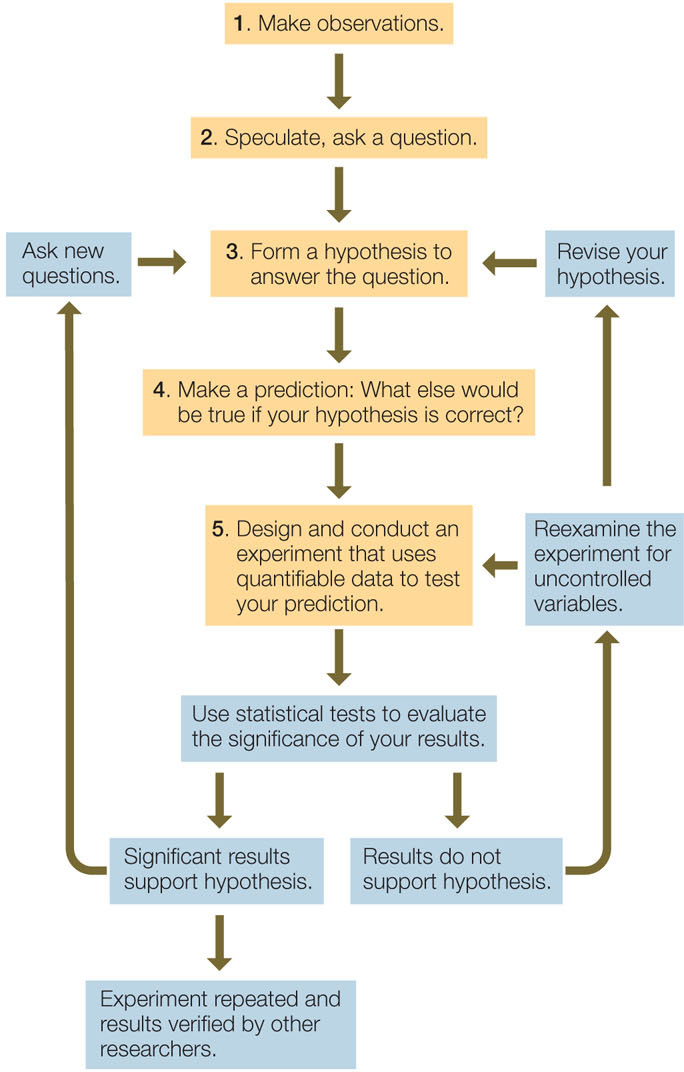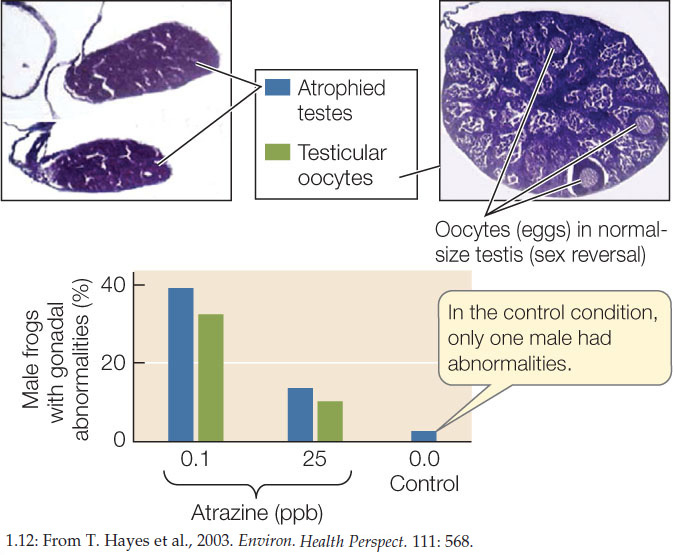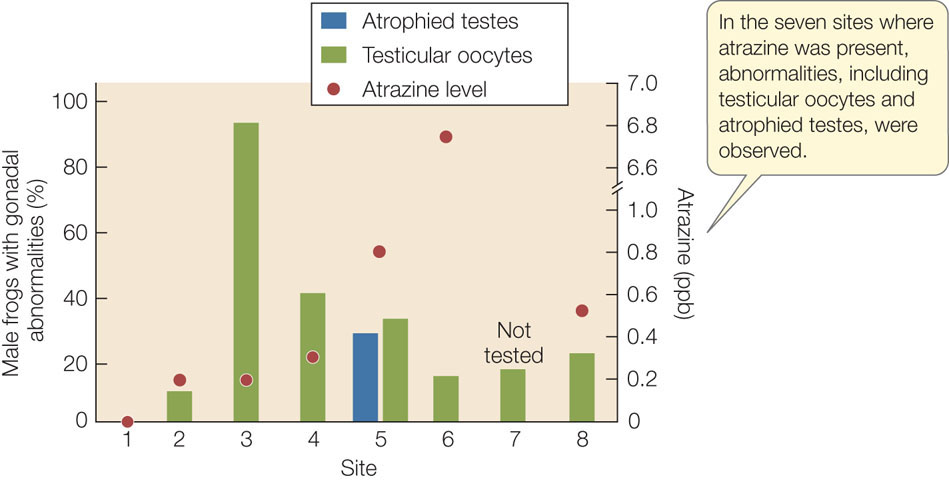Concept 1.5: Science Is Based on Quantitative Observations, Experiments, and Reasoning
Regardless of the many different tools and methods used in research, all scientific investigations are based on quantitative observation, experimentation, and reasoning. In each of these areas, scientists are guided by an established set of scientific methodological principles.
Observing and quantifying are important skills
Many biologists are motivated by their observations of the living world. Learning what to observe in nature is a skill that develops with experience in biology. An intimate understanding of the natural history of a group of organisms—how the organisms get their food, reproduce, behave, regulate their functions, and interact with other organisms—leads to better observations and prompts biologists to ask questions about those observations. The more a biologist knows about general principles of life, the more he or she is likely to gain new insights from observing nature.
Biologists have always observed the world around them, but today our ability to observe is greatly extended by technologies such as electron microscopes, rapid genome sequencing, magnetic resonance imaging, and global positioning satellites. These technologies allow us to observe everything from the distribution of molecules in the body (by using electron microscopes) to the daily movement of animals across continents and oceans (by using global positioning satellites).
Observation is a basic tool of biology, but as scientists we must also be able to quantify our observations—turn the observations into explicit counts or measures. Whether we are testing a new drug or mapping the migrations of whales, mathematical and statistical calculations are essential. For example, biologists once classified organisms entirely on the basis of qualitative descriptions of the physical differences among them. There was no way of objectively determining evolutionary relationships of organisms, and biologists had to depend on the fossil record for insight. Today our ability to quantify the molecular and physical differences among species, combined with explicit mathematical models of the evolutionary process, enables quantitative analyses of evolutionary history. These mathematical calculations, in turn, make it easier to compare all other aspects of the biology of different organisms.
Scientific methods combine observation, experimentation, and logic
Often, science textbooks describe “the scientific method,” as if there is a single flow chart that all scientists follow. This view is an oversimplification. Such flow charts include much of what scientists do, but you should not conclude that scientists necessarily go through these steps in one prescribed, linear order.
Observations lead to questions, and scientists make additional observations and often do experiments to answer those questions. This approach, called the hypothesis–prediction method, has five steps: (1) making observations; (2) asking questions; (3) forming hypotheses, or tentative answers to the questions; (4) making predictions based on the hypotheses; and (5) testing the predictions by making additional observations or conducting experiments. These are the steps in traditional flow charts such as the one shown in FIGURE 1.11.


Go to ANIMATED TUTORIAL 1.2 Using Scientific Methodology
PoL2e.com/at1.2
Getting from questions to answers
Let’s consider an example of how scientists start with a general question and work to find answers. Amphibians—such as the frog in the opening photograph of this chapter—have been around for a long time. They watched the dinosaurs come and go. But today scientists have observed that amphibian populations around the world are in dramatic decline. In quantitative terms, more than a third of the world’s amphibian species are threatened with extinction. Why is this happening?
To answer big questions like this, biologists begin by sifting through what is already known to arrive at possible answers, or hypotheses. In the case of amphibians, biologists know that instances of recent population declines have been associated with various environmental changes such as loss of moist habitats, changing climate, pathogens, or increased quantities of environmental toxins. Tyrone Hayes, a biologist at the University of California at Berkeley, chose to test the hypothesis that frog populations have been adversely affected by agricultural insecticides and herbicides (weed killers). He did so even though several prior studies had shown that many of these chemicals tested at realistic concentrations do not kill amphibians.
13
Hayes focused on atrazine, the most widely used herbicide in the world and a common contaminant in fresh water. More than 70 million pounds of atrazine are applied to farmland in the United States every year, and it is used in at least 20 countries. Atrazine kills several types of weeds that can choke fields of important crops such as corn. The chemical is usually applied before weeds emerge in the spring—at the same time many amphibians are breeding and thousands of tadpoles swim in the ditches, ponds, and streams that receive runoff from farms.
In his laboratory, Hayes and his associates raised frog tadpoles in water containing no atrazine and in water with concentrations ranging from 0.01 parts per billion (ppb) up to 25 ppb. The U.S. Environmental Protection Agency considers environmental levels of atrazine of 10–20 ppb of no concern, and it considers 3 ppb a safe level in drinking water. Rainwater in Iowa has been measured to contain 40 ppb. In Switzerland, where the use of atrazine is illegal, the chemical has been measured at approximately 1 ppb in rainwater.
In the Hayes laboratory, an atrazine concentration as low as 0.1 ppb had a dramatic effect on tadpole development: it feminized the males. In some of the adult males that developed from these tadpoles, the vocal structures used in mating calls were smaller than normal, female sex organs developed, and eggs were found growing in the testes. In other studies, normal adult male frogs exposed to 25 ppb had a tenfold reduction in levels of the male sex hormone testosterone and did not produce sperm. You can imagine the disastrous effects these changes could have on the capacity of frogs to breed and reproduce.
But Hayes’s experiments were performed in the laboratory, with a species of frog bred for laboratory use. Could atrazine be affecting frogs in nature? If so, then developmental abnormalities in natural frog populations should occur where atrazine is present in their environment. Hayes and his students traveled across the middle of North America, sampling water and collecting frogs to test this prediction. They analyzed the water for atrazine and examined the frogs. In the only site where atrazine was undetectable in the water, the frogs were normal. In all the other sites, male frogs had abnormalities of the sex organs.
Like other biologists, Hayes made observations. He then made predictions based on those observations, and designed and carried out experiments to test his predictions. Some of the conclusions from his experiments, described below, could have profound implications not only for amphibians but also for other animals, including humans.
Well-designed experiments have the potential to falsify hypotheses
Once predictions are made from a hypothesis, experiments can be designed to test those predictions. The most informative experiments have the ability to show that the prediction is wrong. If the prediction is wrong, the hypothesis must be modified or rejected.
There are two general types of experiments. Both compare data from different groups or samples. A controlled experiment changes, or manipulates, one or more of the factors being tested. A comparative experiment compares unmanipulated data gathered from different sources.
In a controlled experiment, we start with groups or samples that are as similar as possible. We predict on the basis of our hypothesis that some critical factor, or variable, has an effect on the phenomenon we are investigating. We devise some method to manipulate only that variable in an “experimental” group, and we compare the resulting data with data from an unmanipulated “control” group. If the predicted difference occurs, we then apply statistical tests to find the probability that the manipulation created the difference (as opposed to the difference being the result of random chance). FIGURE 1.12 describes one of the many controlled experiments performed by the Hayes laboratory to quantify the effects of atrazine on male frogs.
Investigation
HYPOTHESIS
Exposure to atrazine during larval development causes abnormalities in the reproductive tissues of male frogs.
METHOD
- Establish 9 tanks in which all attributes are held constant except the water’s atrazine concentration. Establish 3 atrazine conditions (3 replicate tanks per condition): 0 ppb (control condition), 0.1 ppb, and 25 ppb.
- Place Rana pipiens tadpoles from laboratory-reared eggs in the 9 tanks (30 tadpoles per tank).
- When tadpoles have transitioned into adults, sacrifice the animals and evaluate their reproductive tissues.
- Test for relationship between degree of atrazine exposure and the presence of abnormalities in the gonads (testes) of male frogs.
RESULT

CONCLUSION
Exposure to atrazine at concentrations as low as 0.1 ppb induces abnormalities in the gonads of male frogs. The effect is not proportional to the level of exposure.
Go to LaunchPad for discussion and relevant links for all INVESTIGATION figures.
aT. Hayes et al. 2003. Environmental Health Perspectives III: 568–575.
The basis of controlled experiments is that one variable is manipulated while all others are held constant. The variable that is manipulated is called the independent variable (because an investigator can manipulate it independently of other considerations). The response that is measured is the dependent variable (because it is not manipulated directly by the investigator but is permitted to vary in ways that depend on the independent variable). A perfectly controlled experiment is not easy to design because biological variables are so interrelated that it is difficult to alter just one.
A comparative experiment starts with the prediction that there will be a difference among naturally existing samples or groups based on the hypothesis. In comparative experiments, we do not control any of the variables, and often we cannot even identify all the variables that are present. We simply gather and compare data from different naturally occurring sample groups.
When his controlled experiments indicated that atrazine indeed affects reproductive development in frogs, Hayes and his colleagues performed a comparative experiment. They collected frogs and water samples from eight widely separated sites across the United States and compared the percentages of abnormal frogs from environments with very different levels of atrazine (FIGURE 1.13). Of course, the sample sites differed in many ways besides the level of atrazine present.
Investigation
HYPOTHESIS
Presence of the herbicide atrazine in environmental water correlates with gonadal abnormalities in frog populations.
METHOD
- Based on commercial sales of atrazine, select 4 sites (sites 1–4) less likely and 4 sites (sites 5–8) more likely to be contaminated with atrazine.
- Visit all sites in the spring (i.e., when frogs have transitioned from tadpoles into adults), collect frogs and water samples.
- In the laboratory, sacrifice frogs and examine their reproductive tissues, documenting abnormalities.
- Analyze the water samples for atrazine concentration (the sample for site 7 was not tested).
- Quantify and correlate the incidence of reproductive abnormalities with environmental atrazine concentrations.
RESULT

CONCLUSION
Reproductive abnormalities exist in frogs from environments in which aqueous atrazine concentration is 0.2 ppb or above. The frequency of abnormalities does not appear to be proportional to atrazine concentration at the time of transition to adulthood.
Go to LaunchPad for discussion and relevant links for all INVESTIGATION figures.
aT. Hayes et al. 2002. Nature 419: 895–896.
The results of experiments frequently reveal that the situation is more complex than the hypothesis anticipated, thus raising new questions. There are no “final answers” in science. As a result, biologists often develop new questions, hypotheses, and experiments as they collect more data. The process of science is open-ended in this regard, and continued research leads to an ever-better understanding of the living world, with practical implications for agriculture, medicine, conservation of species, and other endeavors.
Statistical methods are essential scientific tools
Whether we do controlled or comparative experiments, at the end we have to decide whether there is a difference among the samples, individuals, groups, or populations in the study. How do we decide whether a measured difference is enough to support or reject a hypothesis? In other words, how do we decide in an unbiased, objective way whether the measured difference is meaningful, or significant?
14
Statistical significance refers to the extent to which a result is unlikely to be due to chance alone. Scientists use statistics because they recognize that variation is always present in any set of measurements. Statistical tests calculate the probability that the differences observed in an experiment could be due to random variation. The results of statistical tests are therefore probabilities. Many statistical tests start with a null hypothesis—the premise that any observed differences are simply the result of random differences that arise from drawing two samples from the same population. When scientists collect quantified observations, or data, they apply statistical methods to those data to calculate the likelihood that the null hypothesis is correct.
More specifically, statistical methods tell us the probability of obtaining a particular result by chance alone, even if the samples being tested are drawn from the same population. As scientists, we need to eliminate, insofar as possible, the possibility that any differences seen are simply due to chance variation in the samples. Appendix B in this book is a short primer on statistical methods that you can refer to as you analyze data that will be presented throughout the text.
Not all forms of inquiry into nature are scientific
Science is a human endeavor that is bounded by certain standards of practice. Other areas of scholarship share with science the practice of making observations and asking questions, but scientists are distinguished by what they do with their observations and how they answer their questions. Data, subjected to appropriate statistical analysis, are critical in testing hypotheses. Science is the most powerful approach humans have devised for learning about the world and how it works.
Scientific explanations for natural processes are objective and reliable because the hypotheses proposed must be testable and must have the potential of being rejected by direct observations and experiments. Scientists must clearly describe the methods they use to test hypotheses so that other scientists can repeat their experiments to see if they get the same results. Not all experiments are repeated, but surprising or controversial results are always subjected to independent verification. Scientists worldwide share this process of testing and rejecting hypotheses, contributing to a common body of scientific knowledge.
If you understand the methods of science, you can distinguish science from non-science. Art, music, and literature all contribute to the quality of human life, but they are not science. They do not use scientific methods to establish what is fact. Religion is not science, although religions have historically attempted to explain natural events ranging from unusual weather patterns to crop failures to human diseases. Most such phenomena that at one time were mysterious can now be explained in terms of scientific principles. Fundamental tenets of religious faith, such as the existence of a supreme deity or deities, cannot be confirmed or refuted by experimentation and for this reason are outside the realm of science.
The power of science derives from the uncompromising objectivity and absolute dependence on evidence that comes from reproducible and quantifiable observations. A religious or spiritual explanation of a natural phenomenon may be coherent and satisfying for the person holding that view, but it is not testable and therefore it is not science. To invoke a supernatural explanation (such as a “creator” or “intelligent designer” with no known bounds) is to depart from the world of science. Science does not say that untestable religious beliefs are necessarily wrong, just that they are not something that we can address using scientific methods.
15
Science describes how the world works. It is silent on the question of how the world “ought to be.” Many scientific advances that contribute to human welfare also raise major ethical issues. Recent developments in genetics and developmental biology may enable us to select the sex of our children, to use stem cells to repair our bodies, and to modify the human genome. Scientific knowledge allows us to do these things, but science cannot tell us whether or not we should do so, or if we choose to do them, how we should regulate them. Such questions are as crucial to human society as the science itself. A responsible scientist does not lose sight of these questions or neglect the contributions of the humanities in attempting to come to grips with them.
Consider the big themes of biology as you read this book
You will see evolution and the other fundamental principles of life introduced in this chapter at work in each part of this book. In Part 1 you will learn about the molecular organization of life. We will discuss the origin of life, the energy in atoms and molecules, and how proteins and nucleic acids became the self-replicating cellular systems of life. Part 2 will describe how these self-replicating systems work and the genetic principles that explain heredity and mutation, which are the basis of evolution. In Part 3 we will describe the processes of evolution and go into detail about how evolution works. Part 4 will examine the products of evolution: the vast diversity of life and the many different ways organisms solve common problems such as how to reproduce, defend themselves, and obtain nutrients. Parts 5 and 6 will explore the physiological adaptations that allow plants and animals to survive and function in a wide range of physical environments. Finally, in Part 7 we will discuss these environments and the integration of individual organisms, populations, and communities into the interrelated ecological systems of Earth.
You may enjoy returning to this chapter occasionally as the course progresses. The brief explanations we have given here should become more meaningful as you read about the facts and phenomena that underlie the principles. Our knowledge of the “facts” of biology, however, is not based just on reading, contemplation, or discussion, although all of these activities are important. Scientific knowledge is based on active and always-ongoing research.
16